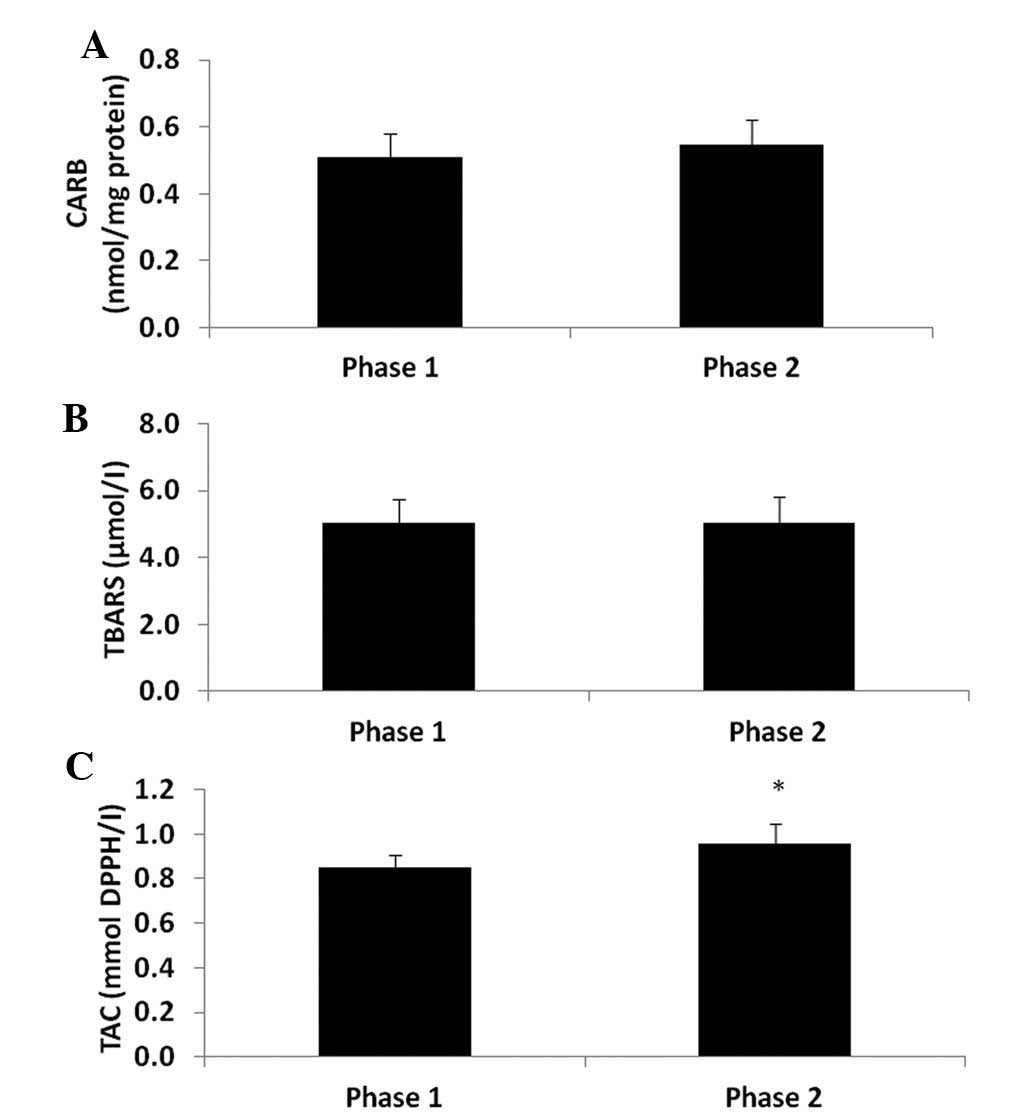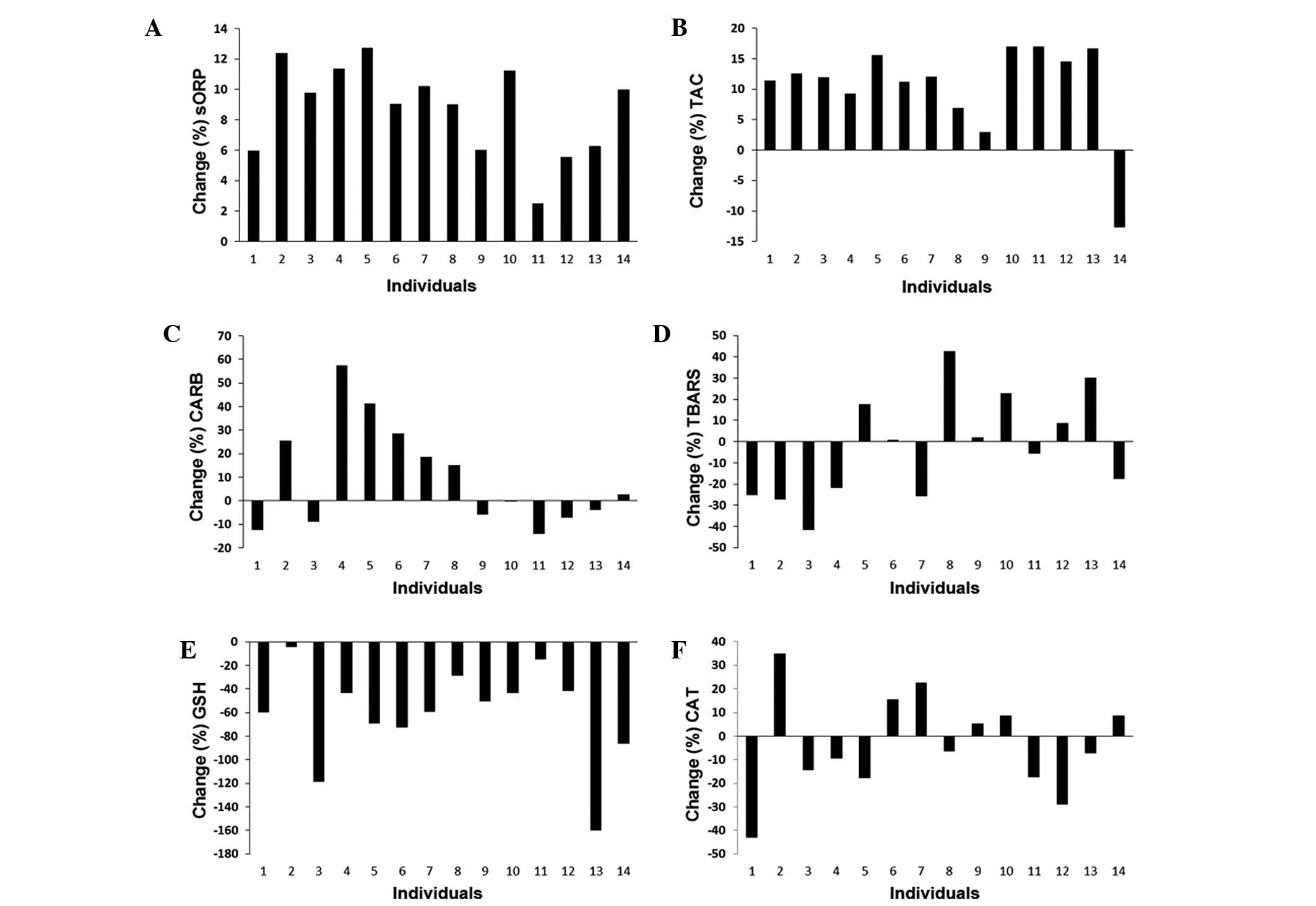|
1
|
Ciuti C, Marcello C, Macis A, Onnis E,
Solinas R, Lai C and Concu A: Improved aerobic power by detraining
in basketball players mainly trained for strength. Sports Med Train
Rehabil. 6:325–335. 1996. View Article : Google Scholar
|
|
2
|
Balčiūnas M, Stonkus S, Abrantes C and
Sampaio J: Long term effects of different training modalities on
power, speed, skill and anaerobic capacity in young male basketball
players. J Sports Sci Med. 5:163–170. 2006.PubMed/NCBI
|
|
3
|
Crisafulli A, Melis F, Tocco F, Laconi P,
Lai C and Concu A: External mechanical work versus oxidative energy
consumption ratio during a basketball field test. J Sports Med Phys
Fitness. 42:409–417. 2002.PubMed/NCBI
|
|
4
|
McInnes SE, Carlson JS, Jones CJ and
McKenna MJ: The physiological load imposed on basketball players
during competition. J Sports Sci. 13:387–397. 1995. View Article : Google Scholar : PubMed/NCBI
|
|
5
|
Veskoukis AS, Nikolaidis MG, Kyparos A,
Kokkinos D, Nepka C, Barbanis S and Kouretas D: Effects of xanthine
oxidase inhibition on oxidative stress and swimming performance in
rats. Appl Physiol Nutr Metab. 33:1140–1154. 2008. View Article : Google Scholar : PubMed/NCBI
|
|
6
|
Nikolaidis MG, Jamurtas AZ, Paschalis V,
Kostaropoulos IA, Kladi-Skandali A, Balamitsi V, Koutedakis Y and
Kouretas D: Exercise-induced oxidative stress in G6PD-deficient
individuals. Med Sci Sports Exerc. 38:1443–1450. 2006. View Article : Google Scholar : PubMed/NCBI
|
|
7
|
Mylonas C and Kouretas D: Lipid
peroxidation and tissue damage. Vivo. 13:295–309. 1999.
|
|
8
|
Schneider BSP and Tiidus PM: Neutrophil
infiltration in exercise-injured skeletal muscle: how do we resolve
the controversy? Sports Med. 37:837–856. 2007. View Article : Google Scholar : PubMed/NCBI
|
|
9
|
Nikolaidis MG, Kyparos A, Hadziioannou M,
Panou N, Samaras L, Jamurtas AZ and Kouretas D: Acute exercise
markedly increases blood oxidative stress in boys and girls. Appl
Physiol Nutr Metab. 32:197–205. 2007. View
Article : Google Scholar : PubMed/NCBI
|
|
10
|
Meeus M, Nijs J, Hermans L, Goubert D and
Calders P: The role of mitochondrial dysfunctions due to oxidative
and nitrosative stress in the chronic pain or chronic fatigue
syndromes and fibromyalgia patients: peripheral and central
mechanisms as therapeutic targets? Expert Opin Ther Targets.
17:1081–1089. 2013. View Article : Google Scholar : PubMed/NCBI
|
|
11
|
Phaneuf S and Leeuwenburgh C: Apoptosis
and exercise. Med Sci Sports Exerc. 33:393–396. 2001. View Article : Google Scholar : PubMed/NCBI
|
|
12
|
McClung JM, Deruisseau KC, Whidden MA, Van
Remmen H, Richardson A, Song W, Vrabas IS and Powers SK:
Overexpression of antioxidant enzymes in diaphragm muscle does not
alter contraction-induced fatigue or recovery. Exp Physiol.
95:222–231. 2010. View Article : Google Scholar : PubMed/NCBI
|
|
13
|
Rodríguez-Alonso M, Fernández-García B,
Pérez-Landaluce J and Terrados N: Blood lactate and heart rate
during national and international women's basketball. J Sports Med
Phys Fitness. 43:432–436. 2003.PubMed/NCBI
|
|
14
|
Finaud J, Lac G and Filaire E: Oxidative
stress: relationship with exercise and training. Sports Med.
36:327–358. 2006. View Article : Google Scholar : PubMed/NCBI
|
|
15
|
Schippinger G, Fankhauser F, Abuja PM,
Winklhofer-Roob BM, Nadlinger K, Halwachs-Baumann G and Wonisch W:
Competitive and seasonal oxidative stress in elite alpine ski
racers. Scand J Med Sci Sports. 19:206–212. 2009. View Article : Google Scholar : PubMed/NCBI
|
|
16
|
Spanidis Y, Goutzourelas N, Stagos D,
Kolyva AS, Gogos CA, Bar-Or D and Kouretas D: Assessment of
oxidative stress in septic and obese patients using markers of
oxidation-reduction potential. Vivo. 29:595–600. 2015.
|
|
17
|
Stagos D, Goutzourelas N, Ntontou AM,
Kafantaris I, Deli CK, Poulios A, Jamurtas AZ, Bar-Or D and
Kouretas D: Assessment of eccentric exercise-induced oxidative
stress using oxidation-reduction potential markers. Oxid Med Cell
Longev. 2015:2046152015. View Article : Google Scholar : PubMed/NCBI
|
|
18
|
Stagos D, Goutzourelas N, Bar-Or D,
Ntontou AM, Bella E, Becker AT, Statiri A, Kafantaris I and
Kouretas D: Application of a new oxidation-reduction potential
assessment method in strenuous exercise-induced oxidative stress.
Redox Rep. 20:154–162. 2015. View Article : Google Scholar : PubMed/NCBI
|
|
19
|
Keles MS, Taysi S, Sen N, Aksoy H and
Akçay F: Effect of corticosteroid therapy on serum and CSF
malondialdehyde and antioxidant proteins in multiple sclerosis. Can
J Neurol Sci. 28:141–143. 2001.PubMed/NCBI
|
|
20
|
Lykkesfeldt J: Malondialdehyde as
biomarker of oxidative damage to lipids caused by smoking. Clin
Chim Acta. 380:50–58. 2007. View Article : Google Scholar : PubMed/NCBI
|
|
21
|
Reddy YN, Murthy SV, Krishna DR and
Prabhakar MC: Role of free radicals and antioxidants in
tuberculosis patients. Indian J Tuberc. 51:213–218. 2004.
|
|
22
|
Patsoukis N, Zervoudakis G, Panagopoulos
NT, Georgiou CD, Angelatou F and Matsokis NA: Thiol redox state
(TRS) and oxidative stress in the mouse hippocampus after
pentylenetetrazol-induced epileptic seizure. Neurosci Lett.
357:83–86. 2004. View Article : Google Scholar : PubMed/NCBI
|
|
23
|
Janaszewska A and Bartosz G: Assay of
total antioxidant capacity: comparison of four methods as applied
to human blood plasma. Scand J Clin Lab Invest. 62:231–236. 2002.
View Article : Google Scholar : PubMed/NCBI
|
|
24
|
Aebi H: Catalase in vitro. Methods
Enzymol. 105:121–126. 1984. View Article : Google Scholar : PubMed/NCBI
|
|
25
|
Margaritelis NV, Veskoukis AS, Paschalis
V, Vrabas IS, Dipla K, Zafeiridis A, Kyparos A and Nikolaidis MG:
Blood reflects tissue oxidative stress: a systematic review.
Biomarkers. 20:97–108. 2015. View Article : Google Scholar : PubMed/NCBI
|
|
26
|
Margaritelis NV, Kyparos A, Paschalis V,
Theodorou AA, Panayiotou G, Zafeiridis A, Dipla K, Nikolaidis MG
and Vrabas IS: Reductive stress after exercise: The issue of redox
individuality. Redox Biol. 2:520–528. 2014. View Article : Google Scholar : PubMed/NCBI
|
|
27
|
Rankinen T and Bouchard C: Gene-physical
activity interactions: Overview of human studies. Obesity (Silver
Spring). 16(Suppl 3): S47–S50. 2008. View Article : Google Scholar : PubMed/NCBI
|
|
28
|
Zembron-Lacny A, Slowinska-Lisowska M and
Ziemba A: Integration of the thiol redox status with cytokine
response to physical training in professional basketball players.
Physiol Res. 59:239–245. 2010.PubMed/NCBI
|
|
29
|
Melikoglu MA, Kaldirimci M, Katkat D, Sen
I, Kaplan I and Senel K: The effect of regular long term training
on antioxidant enzymatic activities. J Sports Med Phys Fitness.
48:388–390. 2008.PubMed/NCBI
|
|
30
|
Zembron-Lacny A, Naczk M, Gajewski M,
Ostapiuk-Karolczuk J, Dziewiecka H, Kasperska A and Szyszka K:
Changes of muscle-derived cytokines in relation to thiol redox
status and reactive oxygen and nitrogen species. Physiol Res.
59:945–951. 2010.PubMed/NCBI
|
|
31
|
Ji LL, Gomez-Cabrera MC and Vina J:
Exercise and hormesis: activation of cellular antioxidant signaling
pathway. Ann N Y Acad Sci. 1067:425–435. 2006. View Article : Google Scholar : PubMed/NCBI
|
|
32
|
Kerksick C and Willoughby D: The
antioxidant role of glutathione and N-acetyl-cysteine supplements
and exercise-induced oxidative stress. J Int Soc Sports Nutr.
2:38–44. 2005. View Article : Google Scholar : PubMed/NCBI
|
|
33
|
Steensberg A, van Hall G, Osada T,
Sacchetti M, Saltin B and Klarlund Pedersen B: Production of
interleukin-6 in contracting human skeletal muscles can account for
the exercise-induced increase in plasma interleukin-6. J Physiol.
529:237–242. 2000. View Article : Google Scholar : PubMed/NCBI
|
|
34
|
Chatzinikolaou A, Draganidis D, Avloniti
A, Karipidis A, Jamurtas AZ, Skevaki CL, Tsoukas D, Sovatzidis A,
Theodorou A, Kambas A, et al: The microcycle of inflammation and
performance changes after a basketball match. J Sports Sci.
32:870–882. 2014. View Article : Google Scholar : PubMed/NCBI
|
|
35
|
Wiggs MP: Can endurance exercise
preconditioning prevention disuse muscle atrophy? Front Physiol.
6:632015. View Article : Google Scholar : PubMed/NCBI
|
|
36
|
Oh-ishi S, Kizaki T, Nagasawa J, Izawa T,
Komabayashi T, Nagata N, Suzuki K, Taniguchi N and Ohno H: Effects
of endurance training on superoxide dismutase activity, content and
mRNA expression in rat muscle. Clin Exp Pharmacol Physiol.
24:326–332. 1997. View Article : Google Scholar : PubMed/NCBI
|
|
37
|
Smuder AJ, Kavazis AN, Min K and Powers
SK: Exercise protects against doxorubicin-induced oxidative stress
and proteolysis in skeletal muscle. J Appl Physiol 1985.
110:935–942. 2011. View Article : Google Scholar : PubMed/NCBI
|
|
38
|
Mangner N, Linke A, Oberbach A, Kullnick
Y, Gielen S, Sandri M, Hoellriegel R, Matsumoto Y, Schuler G and
Adams V: Exercise training prevents TNF-α induced loss of force in
the diaphragm of mice. PLoS One. 8:e522742013. View Article : Google Scholar : PubMed/NCBI
|
|
39
|
Fatouros IG, Jamurtas AZ, Villiotou V,
Pouliopoulou S, Fotinakis P, Taxildaris K and Deliconstantinos G:
Oxidative stress responses in older men during endurance training
and detraining. Med Sci Sports Exerc. 36:2065–2072. 2004.
View Article : Google Scholar : PubMed/NCBI
|
|
40
|
Wiecek M, Maciejczyk M, Szymura J and
Szygula Z: Changes in oxidative stress and acid-base balance in men
and women following maximal-intensity physical exercise. Physiol
Res. 64:93–102. 2015.PubMed/NCBI
|
|
41
|
Bloomer RJ and Fisher-Wellman KH: Blood
oxidative stress biomarkers: influence of sex, exercise training
status, and dietary intake. Gend Med. 5:218–228. 2008. View Article : Google Scholar : PubMed/NCBI
|
|
42
|
Gul M, Demircan B, Taysi S, Oztasan N,
Gumustekin K, Siktar E, Polat MF, Akar S, Akcay F and Dane S:
Effects of endurance training and acute exhaustive exercise on
antioxidant defense mechanisms in rat heart. Comp Biochem Physiol A
Mol Integr Physiol. 143:239–245. 2006. View Article : Google Scholar : PubMed/NCBI
|
|
43
|
Powers SK and Jackson MJ: Exercise-induced
oxidative stress: Cellular mechanisms and impact on muscle force
production. Physiol Rev. 88:1243–1276. 2008. View Article : Google Scholar : PubMed/NCBI
|
|
44
|
Rahal A, Kumar A, Singh V, Yadav B, Tiwari
R, Chakraborty S and Dhama K: Oxidative stress, prooxidants, and
antioxidants: the interplay. BioMed Res Int. 2014:7612642014.
View Article : Google Scholar : PubMed/NCBI
|
|
45
|
Nikolaidis MG, Jamurtas AZ, Paschalis V,
Fatouros IG, Koutedakis Y and Kouretas D: The effect of
muscle-damaging exercise on blood and skeletal muscle oxidative
stress: magnitude and time-course considerations. Sports Med.
38:579–606. 2008. View Article : Google Scholar : PubMed/NCBI
|
|
46
|
Pliauga V, Kamandulis S, Dargevičiūtė G,
Jaszczanin J, Klizienė I, Stanislovaitienė J and Stanislovaitis A:
The effect of a simulated basketball game on players' sprint and
jump performance, temperature and muscle damage. J Hum Kinet.
46:167–175. 2015. View Article : Google Scholar : PubMed/NCBI
|
|
47
|
Pyne DB: Exercise-induced muscle damage
and inflammation: a review. Aust J Sci Med Sport. 26:49–58.
1994.PubMed/NCBI
|















